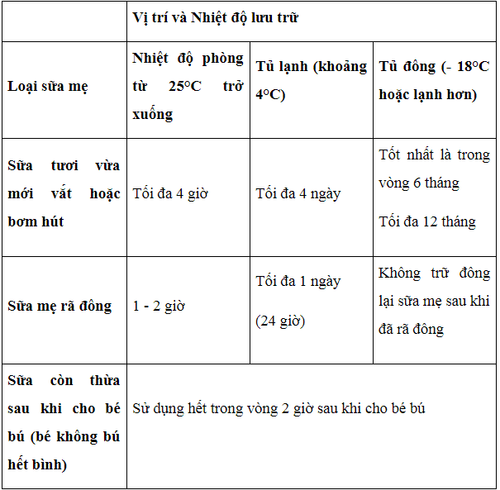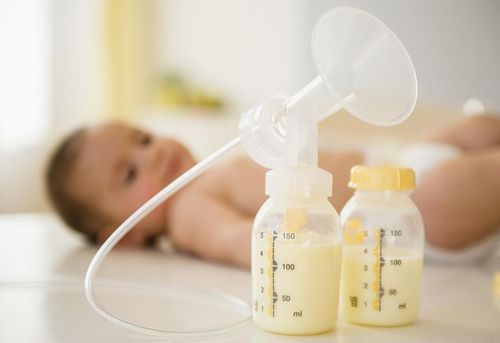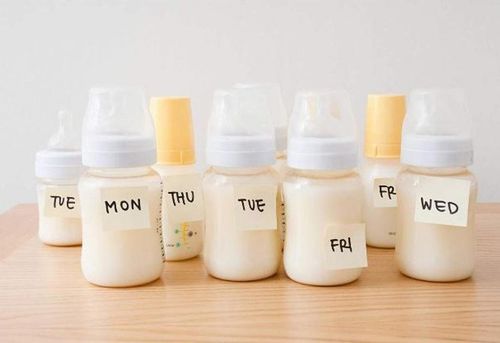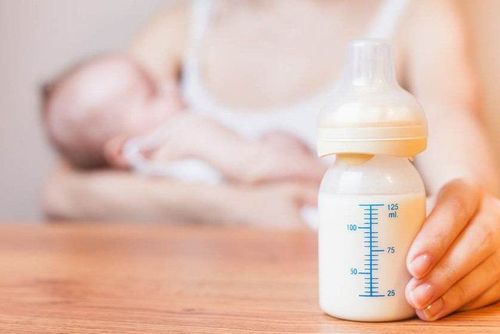This is an automatically translated article.
The article is professionally consulted by Master, Doctor Huynh Bao Toan - Department of Pediatrics - Neonatology - Vinmec Nha Trang International General Hospital.
To maintain the quality of expressed breast milk and ensure the safety of the baby's health, nursing mothers as well as caregivers should follow the scientific way of storing breast milk, as recommended by experts. recommended nutrition.
1. How to store breast milk safely
1.1. Before expressing breast milk Hygiene is very important not only when storing and storing breast milk, but also from the initial expressing or pumping step. The mother should note the following before expressing milk:Wash hands thoroughly with soap and water, or use hand sanitizer containing at least 60% alcohol; Breast milk can be expressed by hand, with a hand pump or an electric pump; If a pump is used, check the pump kit and hoses for cleanliness. Discard and replace immediately if tubes are moldy or not clean; Wipe the buttons, power switch and pump surface with a cloth moistened with cleaning solution. 1.2. Store breast milk after expressing Choose the right milk bottle or bag:
Use a dedicated breast milk storage plastic bag or a clean container with a tight-fitting lid made of glass or plastic to store expressed breast milk. You can buy these items in a supermarket or a reputable pharmacy; Avoid plastic bottles with the recycling symbol 7 as this material can be made of BPA-containing plastic; Do not store breast milk in disposable bottles or regular plastic bags, not specifically designed to store breast milk. Storage time for breast milk:
At room temperature: For up to 4 hours; In the refrigerator: Up to 4 days; In the freezer: Best for about 6 months, but can also be stored for up to 12 months.

Trắc nghiệm: Thế nào là trẻ sơ sinh non tháng?
Trẻ sơ sinh non tháng rất cần được chăm và điều trị thật tốt để giúp giảm nguy cơ gặp phải các di chứng về tinh thần, vận động và sự phát triển sau này. Cùng theo dõi bài trắc nghiệm dưới đây để có thể nhận biết trẻ sơ sinh non tháng và có thêm kiến thức chăm sóc, nuôi dưỡng tốt nhất cho trẻ.The following content is prepared under supervision of Thạc sĩ, Bác sĩ y khoa, Ma Văn Thấm , Nhi , Phòng khám Đa khoa Quốc tế Vinmec Dương Đông(Phú Quốc)
2. Guide to defrosting breast milk safely
Follow the principle of first in, first out: Always defrost before the bottle with the longest expressed date stated on the label because over time the quality of breast milk can decrease; How to defrost breast milk: Leave the bottle in the refrigerator overnight, if you need to defrost quickly, put it in a basin of warm water or under warm running water; Do not defrost or heat breast milk in the microwave: High heat and microwaves can destroy the nutrients, enzymes and immune antibodies of breast milk, in addition to burning baby's mouth due to hot and cold parts erratic; Use breast milk within 24 hours of defrosting in the refrigerator: Time is counted from the time the milk is completely thawed, not from the moment the bottle is removed from the milk storage cabinet; Once thawed breast milk returns to room temperature or is warmed after the storage period, it should be used within 2 hours. Do not freeze breast milk again after it has been defrosted. In addition, after storing breast milk in the milk storage cabinet, layer separation may occur, so shake the bottle gently to mix the cream fat. If the baby doesn't finish the bottle, the leftovers can still be used within the next 2 hours, after this time should be discarded.3. How to warm breast milk?

Always keep the container tightly closed while reheating; Warm breast milk by placing the container in a basin of warm water or running warm (not hot) water over the container for a few minutes; Do not heat breast milk directly on the stove or in the microwave; Test the temperature of breast milk before feeding your baby by placing a few drops on your wrist. Appropriate warmth is equivalent to body temperature. Various factors, such as volume of milk, room temperature, regulated temperature in the milk storage cabinet, and cleanliness of the environment, can affect how long breast milk can be safely stored. While freezing can keep food safe for a very long time, following the recommended shelf life and storage requirements of breast milk is important to ensure the quality of your milk. The best amount for your baby.
As a key area of Vinmec Health system, Pediatrics Department always brings satisfaction to customers and is highly appreciated by industry experts with:
Gathering a team of top doctors and nurses in Pediatrics : consists of leading experts with high professional qualifications (professors, associate professors, doctorates, masters), experienced, worked at major hospitals such as Bach Mai, 108.. Doctors All doctors are well-trained, professional, conscientious, knowledgeable about young psychology. In addition to domestic pediatric specialists, the Department of Pediatrics also has the participation of foreign experts (Japan, Singapore, Australia, USA) who are always pioneers in applying the latest and most effective treatment regimens. . Comprehensive services: In the field of Pediatrics, Vinmec provides a series of continuous medical examination and treatment services from Newborn to Pediatric and Vaccine,... according to international standards to help parents take care of their baby's health from birth to childhood. from birth to adulthood Specialized techniques: Vinmec has successfully deployed many specialized techniques to make the treatment of difficult diseases in Pediatrics more effective: neurosurgery - skull surgery, stem cell transplantation. blood in cancer treatment. Professional care: In addition to understanding children's psychology, Vinmec also pays special attention to the children's play space, helping them to have fun and get used to the hospital's environment, cooperate in treatment, improve the efficiency of medical treatment. For more nutritional knowledge and child care for each age, parents should regularly visit the website vimec.com and make an appointment with the leading doctors, pediatric and nutrition experts of the International General Hospital. Vinmec when needing advice on children's health.
Reference source: parents.com; cdc.gov















